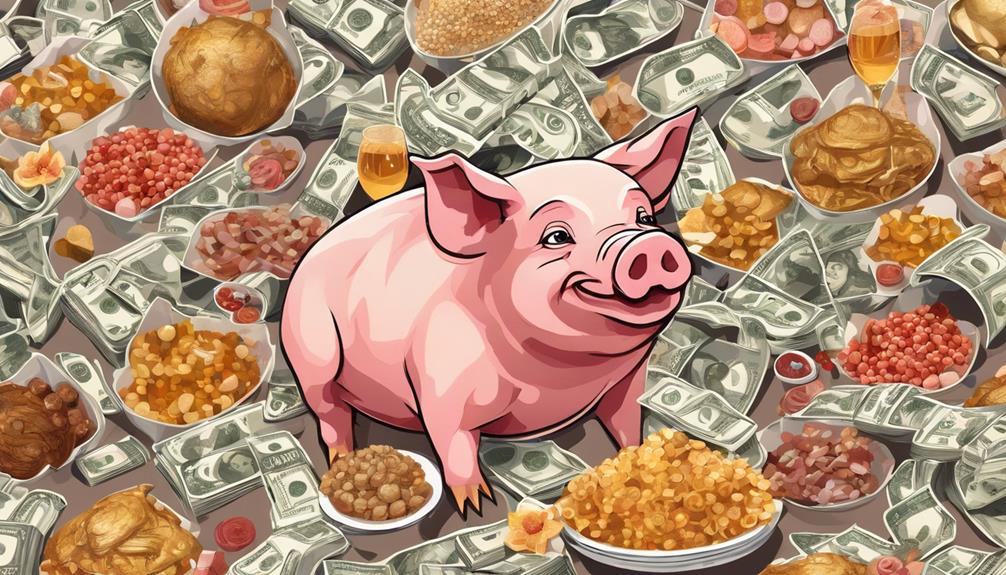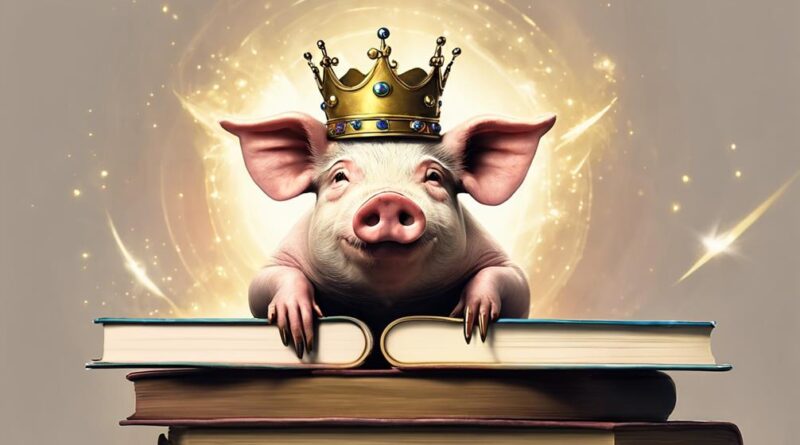Seven Key Symbolic Representations of Pigs in Literature
When exploring the world of literature, pigs are like multifaceted jewels, each facet reflecting a different symbolic representation.
From embodying gluttony to representing intelligence, these creatures have been utilized in various contexts to convey deeper meanings.
As you unravel the intricate web of symbolism surrounding pigs, you'll find yourself captivated by the rich tapestry they weave throughout literary works, shedding light on human nature and societal constructs in unexpected ways.
Pigs as Gluttony Symbols
Why do pigs frequently symbolize gluttony in literature? Pigs as culinary icons have a long history in various cultures, often associated with abundance and indulgence. In literature, pigs are commonly used as food symbolism to represent excess and overconsumption. Their portrayal as voracious eaters reflects the idea of gluttony, a theme explored by many writers to convey deeper meanings.
In stories, pigs are often depicted as creatures with insatiable appetites, constantly seeking out food and consuming without restraint. This portrayal links them to the concept of gluttony, one of the seven deadly sins. By using pigs as symbols of gluttony, authors can critique societal attitudes towards overindulgence and excess.
Furthermore, pigs as food symbolism can also serve as a commentary on human behavior. The association of pigs with gluttony highlights the temptation to overconsume and the consequences of such actions. Through this symbolism, writers can explore themes of greed, excess, and the destructive nature of indulgence.
Pigs as Ignorance Symbols
Pigs, in literature, are frequently utilized as symbols of ignorance, portraying a lack of knowledge or awareness through their characterization. These creatures often embody both innocence and ignorance in various narratives. Pigs symbolize ignorance by representing a lack of understanding or insight into the world around them. Their innocence is often tied to this ignorance, as they navigate their surroundings with a sense of naivety and simplicity.
In many stories, pigs undergo a transformation that highlights their initial state of ignorance. Through their experiences and interactions, they gradually gain knowledge and awareness, shedding their ignorance like a cloak. This transformation is a powerful literary device that showcases the potential for growth and learning even in the most unaware characters.
Pigs as Innocence Symbols
Symbolizing purity and naivety, pigs in literature often serve as embodiments of innocence. In various literary works, pigs are depicted as symbols of innocence and purity, conveying a sense of untainted goodness. Here are some ways in which pigs are used to represent innocence:
- Gentle Demeanor: Pigs are often portrayed as gentle creatures, emphasizing their innocence and harmlessness. Their docile nature contributes to their depiction as symbols of purity.
- Curious Exploration: In some stories, pigs exhibit a curious and exploratory nature, mirroring the innocence of a child discovering the world. This sense of wonder and curiosity showcases their innocence depiction.
- Trust and Loyalty: Pigs are frequently depicted as loyal companions, showcasing their innocence through unwavering trust in others. Their loyalty symbolizes a pure and genuine connection with those around them.
- Playfulness and Joy: Pigs engaging in playful activities evoke a sense of innocence and joy. Their carefree demeanor and playful antics serve as a reminder of the purity found in simple pleasures.
Through these various representations, pigs in literature effectively embody the concept of innocence, serving as poignant symbols of purity and naivety.
Pigs as Greed Symbols
Portrayed as symbols of innocence in literature, pigs undergo a transformation to represent greed, embodying a stark contrast to their previous depiction. Pigs are often utilized in literature as symbols of wealth accumulation, showcasing how the pursuit of material possessions can lead to moral corruption. This depiction stems from the idea that pigs, known for their voracious appetite and tendency to overindulge, can embody the negative aspects of human greed.
In various literary works, pigs are used to highlight the consequences of unbridled greed. Characters who exhibit pig-like behavior in their relentless pursuit of riches often end up morally bankrupt, consumed by their desire for material wealth. The symbolism of pigs as greed symbols serves as a cautionary tale, warning against the dangers of prioritizing money and possessions above all else.
Moreover, the association of pigs with wealth accumulation and moral corruption underscores the idea that greed can lead individuals down a path of moral decay. By portraying pigs in this light, authors draw attention to the pitfalls of unchecked avarice and the importance of maintaining ethical standards in the face of temptation. Through the symbolic representation of pigs as greed symbols, literature serves as a mirror to society, reflecting the consequences of prioritizing greed over integrity.
Pigs as Transformation Symbols
In literature, pigs serve as powerful symbols of transformation, embodying shifts in character or circumstances that bring about profound change. Pigs as transformation symbols can represent various aspects of change, growth, and evolution in a narrative. Here are four ways in which pig imagery is used to symbolize transformation:
- Metaphorical Evolution: Pigs start as small, vulnerable creatures and grow into strong, resilient animals. This growth mirrors the transformation of characters who overcome challenges and develop inner strength.
- Turning Point: The introduction of a pig in a story can mark a turning point where characters undergo a significant transformation. The pig's presence often catalyzes events that lead to personal growth or change in the narrative.
- Cyclical Renewal: Pigs are associated with cycles of life and renewal due to their reproductive abilities. This imagery can symbolize the cyclical nature of transformations, where characters experience repeated changes or rebirths.
- Unconventional Change: Pigs challenge traditional notions of transformation by embodying unconventional or unexpected changes. Their symbolism can represent unique paths to growth or shifts in circumstances that defy norms.
Through these nuanced representations, pigs as transformation symbols offer rich layers of meaning that enhance the depth and complexity of literary works.
Pigs as Rebellion Symbols
Pigs in literature often serve as potent symbols of defiance and resistance, embodying themes of rebellion and subversion. The portrayal of pigs as rebellion symbols can be seen as a societal critique, reflecting the desire to challenge authority and break free from oppressive systems.
In George Orwell's 'Animal Farm,' the pigs take on the role of the ruling class and use their intelligence to manipulate and control the other animals, symbolizing the corruption of power. The rebellion symbolism is evident in how the pigs initially lead the revolution for equality but end up becoming even more oppressive than the humans they overthrew.
Similarly, in William Golding's 'Lord of the Flies,' the character of Jack Merridew and his tribe of hunters represent rebellion against civilized society. The hunt for the sow, which ends in a brutal slaughter, showcases the descent into savagery and the rejection of societal norms. The pigs in this context serve as a stark reminder of the darker impulses that can surface when rebellion goes unchecked.
Pigs as Excess Symbols

Symbolizing indulgence and opulence, pigs in literature often embody themes of excess and extravagance. When pigs are used as excess symbols, they serve as a reflection of societal values and behaviors related to excessive consumption. Here's how pigs are depicted in literature to convey these ideas:
- Feasting: Pigs are frequently shown indulging in grand feasts, eating to excess, and embodying gluttony. This imagery reflects the concept of overconsumption and the consequences it can have.
- Hoarding: In some stories, pigs are portrayed as hoarders, amassing wealth or resources beyond what they need. This behavior highlights the theme of greed and excess in society.
- Luxury: Pigs living in luxurious settings, surrounded by opulence and extravagance, symbolize a society obsessed with material wealth and status symbols.
- Waste: Pigs wallowing in filth and excess can represent the squandering of resources and the negative impact of unchecked indulgence on the environment. This imagery serves as a commentary on the consequences of unrestrained consumption.
Through these depictions, authors use pigs as symbols to critique societal norms and behaviors related to excess, urging readers to reflect on the repercussions of unchecked consumption and the pursuit of extravagance.
Pigs as Intelligence Symbols
Portrayed in literature as cunning and insightful creatures, pigs often serve as symbols of intelligence and wit. Through various literary works, pigs are commonly depicted as wisdom symbols, showcasing their ability to navigate complex situations with astuteness.
In George Orwell's 'Animal Farm,' the pig named Snowball represents intelligence and strategic thinking, using his cleverness to devise plans for the animals' rebellion. Similarly, in E.B. White's 'Charlotte's Web,' the character of Charlotte the spider forms a close bond with Wilbur the pig, highlighting the pig's capacity for understanding and emotional depth. This portrayal of pigs as wise beings emphasizes their ability to perceive and comprehend the world around them in nuanced ways.
Moreover, pigs as cleverness symbols are evident in traditional fables and folktales where they often outsmart other animals through quick thinking and resourcefulness. In Aesop's fable 'The Three Little Pigs,' the pig who builds his house from bricks demonstrates foresight and intelligence compared to his counterparts. This representation underscores the idea of pigs as creatures capable of using their intellect to overcome challenges and emerge victorious. Overall, the depiction of pigs as intelligence symbols in literature reinforces the notion of these animals possessing a depth of understanding and cognitive prowess that's often underestimated.
Frequently Asked Questions
What Are Some Common Misconceptions About Pigs as Gluttony Symbols?
When it comes to pigs as symbols of gluttony, there are some misconceptions. Cultural significance often portrays pigs as overly indulgent, but this isn't always accurate.
Pig myths have contributed to these stereotypes. However, considering evolutionary traits and pig intelligence, it's clear that pigs are more complex than just symbols of excess.
Understanding their nature can help dispel these misconceptions and appreciate the true essence of these animals.
How Do Pigs as Ignorance Symbols Differ Across Different Cultural Interpretations?
When looking at pigs as ignorance symbols in different cultural interpretations, you'll notice a variety of symbolic meanings. Societal perceptions often link pigs to ignorance due to traditional stereotypes.
However, literary portrayals can challenge these narratives by showcasing pigs as intelligent creatures. This divergence in how pigs are viewed highlights the complexity of symbolism and the importance of considering multiple perspectives when analyzing these animals in literature.
Are There Any Notable Literary Examples Where Pigs as Innocence Symbols Are Portrayed Negatively?
In some literature, pigs as symbols of innocence corrupted are portrayed with negative connotations. These portrayals often highlight a shift from purity to tainted nature, reflecting deeper themes of moral decay or betrayal.
In What Ways Do Pigs as Greed Symbols Reflect Societal Attitudes Towards Wealth and Materialism?
When considering societal attitudes towards wealth, pigs as symbols of greed offer a poignant reflection.
The representation of pigs in literature often critiques materialism, highlighting the negative impacts of excessive focus on wealth.
Through the symbolism of pigs, authors convey a cautionary tale about the dangers of prioritizing material possessions above all else.
This portrayal serves as a stark reminder of the potential pitfalls of a society overly fixated on material wealth.
Can You Provide Examples of Pigs as Intelligence Symbols in Literature That Challenge Traditional Stereotypes About Pigs?
When it comes to pigs, intelligence, and stereotypes in literature, there are examples that challenge traditional views.
Pigs have been portrayed as clever and wise creatures in some stories, breaking away from the usual stereotypes of them being dull or greedy.
These alternative depictions of pigs as intelligent beings push against the traditional symbolism associated with them, offering a fresh perspective on their character and abilities.
Conclusion
In conclusion, pigs in literature serve as powerful symbolic representations across various themes such as gluttony, ignorance, innocence, greed, transformation, rebellion, excess, and intelligence. Through their multifaceted symbolism, pigs offer deeper insights into human nature, societal norms, and moral values.
Whether portrayed as negative or positive symbols, pigs play a significant role in enriching the literary landscape and provoking thought-provoking discussions on the complexities of human behavior.
